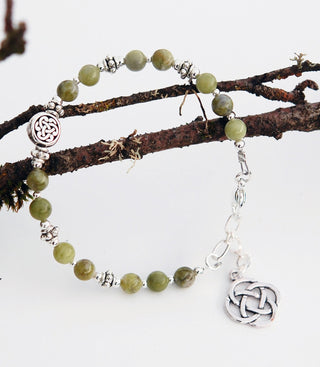Celtic bracelet with 6mm Connemara Marble beads and solid Celtic knot bead and open Celtic knot drop. Comes gift box with the history of Connemara Marble and meaning of the Celtic knot.
History of Connemara Marble
Beloved by the Irish people for centuries, Connemara Marble dates back some 600 million years to the pre-Cambrian era. Steeped in myth and mystery and found only in the twelve Connemara mountains in the West of Ireland, this rich mossy green marble has long been considered one of Ireland’s greatest national treasures.
Stone defines Ireland’s sacred spaces, and it is in the permanence of stone that fragments of the Irish past are recorded. Even before the Celts arrived in Ireland, Neolithic (New Stone Age) peoples were skilled in stonework. Over the ages, Irish artisans have celebrated their history and faith, both Pagan and Christian, by working Connemara Marble into artwork ranging from great monuments to small adornments.
This famous Irish marble shows twisted and interlocking bands of serpentine in varying shades of green, sepia, cream and grey interrupted by veins of crystalline calcite and dolomite and was a treasured commodity used in trade by the inhabitants of prehistoric Ireland.
Held close, the Ancients believed Connemara Marble brings the wearer serenity, restfulness and deep peace.
Meaning of the Celtic Round Lugh Knot
All Celtic knots, whether square, triangle or round, symbolize “no beginning, no end... infinity,” the intertwining of this world and the “other” or spiritual world, the continuity of life paths, the mingling of relationships, and the binding together of all.
The history of the Celts is an oral one and the exact meaning of their artwork, including all Celtic knots, is unsure. However scholars believe the round Lugh knot comes from Celtic mythology with Lugh being the Celtic god of Harvest; to this day a festival called Lughnasa is celebrated, in Ireland and in the Celtic Isles, halfway between the Summer solstice and Autumn equinox
Please allow 2-4 weeks if out of stock
Celtic bracelet with 6mm Connemara Marble beads and solid Celtic knot bead and open Celtic knot drop. Comes gift box with the history of Connemara Marble and meaning of the Celtic knot.
History of Connemara Marble
Beloved by the Irish people for centuries, Connemara Marble dates back some 600 million years to the pre-Cambrian era. Steeped in myth and mystery and found only in the twelve Connemara mountains in the West of Ireland, this rich mossy green marble has long been considered one of Ireland’s greatest national treasures.
Stone defines Ireland’s sacred spaces, and it is in the permanence of stone that fragments of the Irish past are recorded. Even before the Celts arrived in Ireland, Neolithic (New Stone Age) peoples were skilled in stonework. Over the ages, Irish artisans have celebrated their history and faith, both Pagan and Christian, by working Connemara Marble into artwork ranging from great monuments to small adornments.
This famous Irish marble shows twisted and interlocking bands of serpentine in varying shades of green, sepia, cream and grey interrupted by veins of crystalline calcite and dolomite and was a treasured commodity used in trade by the inhabitants of prehistoric Ireland.
Held close, the Ancients believed Connemara Marble brings the wearer serenity, restfulness and deep peace.
Meaning of the Celtic Round Lugh Knot
All Celtic knots, whether square, triangle or round, symbolize “no beginning, no end... infinity,” the intertwining of this world and the “other” or spiritual world, the continuity of life paths, the mingling of relationships, and the binding together of all.
The history of the Celts is an oral one and the exact meaning of their artwork, including all Celtic knots, is unsure. However scholars believe the round Lugh knot comes from Celtic mythology with Lugh being the Celtic god of Harvest; to this day a festival called Lughnasa is celebrated, in Ireland and in the Celtic Isles, halfway between the Summer solstice and Autumn equinox
Please allow 2-4 weeks if out of stock

